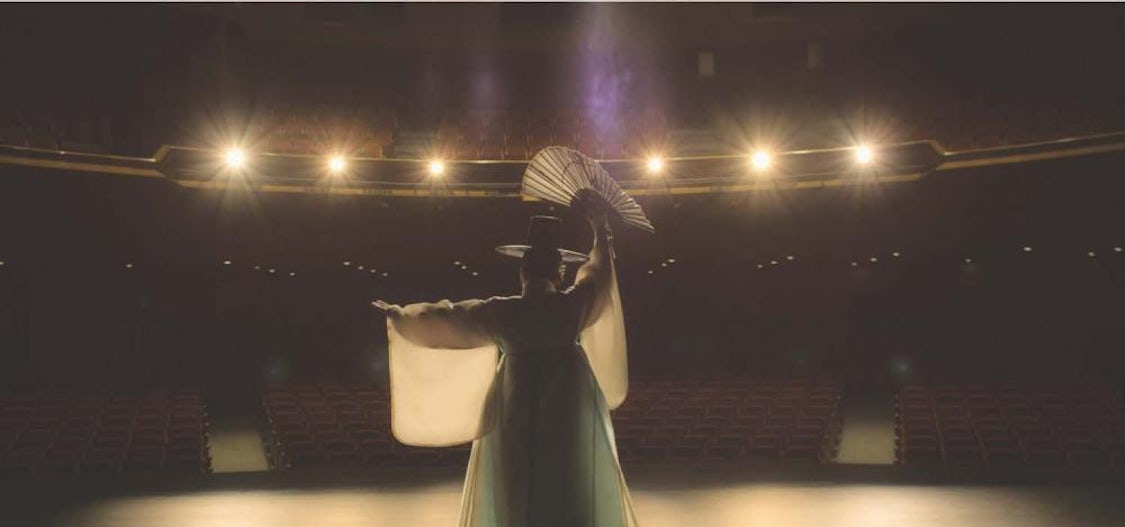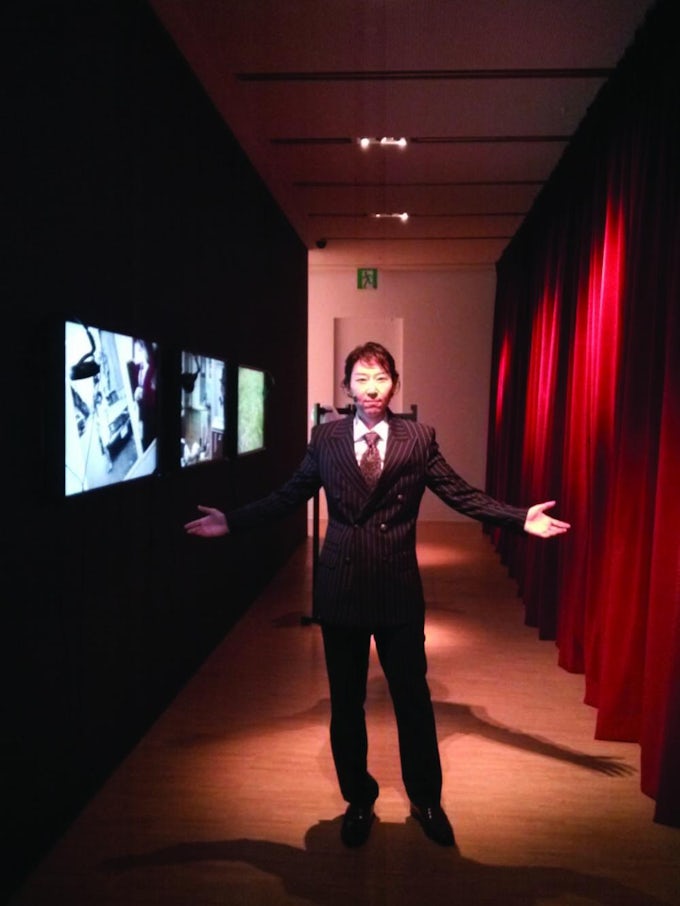
siren eun young jung’s Yeoseong Gukgeuk Project (여성국극 프로젝트, 2008–ongoing) attends to the remnants and remainders of yeoseong gukgeuk (여성국극), a little-known form of performance that first emerged in Korea during the 1940s. Today, yeoseong gukgeuk is on the verge of extinction. With its melodramatic tales of war and romance, set to the plaintive drumming of the barrel-shaped buk (북), yeoseong gukgeuk resembles a more popular style of Korean opera known as changgeuk (창극), usually performed by men. What distinguishes it from changgeuk – and perhaps what consigns it to the peripheries of the Korean performing arts – is its queer regard for the fluidity and fragility of gender. Its ensembles consist only of women who, wearing appliqué beards and silken hanboks (한복), take to the stage as men in archetypal male roles: the hero, the joker, the villain.
In its approach to gender, yeoseong gukgeuk departs somewhat from its analogues in American drag culture. Preferring intense sincerity to the more playful sensibilities of camp and limiting their pursuits of hero/joker/villain realness to the theatrical stage, yeoseong gukgeuk performers do not trouble gender by parodying or passing as men; their aim is neither to mock manhood nor to impersonate it. Instead, the women of yeoseong gukgeuk push back against dominant forms of masculinity by producing one that is all their own: a masculinity without men. Yeoseong gukgeuk performers author, rather than appropriate, alternative manhoods that are no less real than those created by men. In doing so, they embody what queer theorist Jack Halberstam has called ‘female masculinity’, a category of gender expression that challenges men’s claim to manhood. 01As Halberstam argues, ‘masculinity does not belong to men’ and ‘has not been produced only by men’. 02 In yeoseong gukgeuk, masculinity is neither skewered nor imitated. Rather, masculinity is generated – through precise modulations of ‘voice, gesture, emotion and attitude’, in the words of one of its practitioners. 03 Yeoseong gukgeuk demonstrates that gender is both malleable and makeable.
Simultaneously panoramic and kaleidoscopic, jung’s Yeoseong Gukgeuk Project documents – through video, photography and installation – the time jung spent with several surviving yeoseong gukgeuk practitioners as they reflected on the origins and legacies of their craft. Assembled from nearly a decade’s worth of exchanges with these women in their homes and at theatres, backstage and onstage, choreographed and improvised, jung’s elegiac collection examines gender and its performance; reality and its representation; history and its telling; time and its passing. Death hangs over every piece: the first and second generations of performers are either dead or dying, and once they are gone, the tradition itself might not have much longer to live. In many ways, yeoseong gukgeuk is already beyond recovery. jung articulates its ongoing dispersal and disintegration by showing it in fragments, flung across media and gathered into an imagined – a wished-for – whole.

Though most of the women featured in Yeoseong Gukgeuk Project are ‘grannies’ (할머니), as jung calls them, a few are significantly younger than these older performers who are in their seventies and eighties. 04 jung’s two-part piece Act of Affect (정동의 막, 2013) enlists Eunjin Nam (남은진), a latecomer to the tradition whose expertise lies in playing the romantic male lead, the nimai (니마이). Through Nam, who is in her forties, jung examines not just yeoseong gukgeuk’s unforeseeable future but also the affective intensities that limn its wavering present. Act of Affect documents the ruins of yeoseong gukgeuk through what literary scholar Heather Love calls the ‘forms of ruined subjectivity’ created by its gradual loss – a ruination that is, Love says, inescapably part of ‘the history of queer experience’. 05 In keeping, then, with the investments in affect that have long informed queer and feminist theory and politics, 06 Act of Affect offers an account of yeoseong gukgeuk’s decline through an intimate catalogue of feeling: the boredom of rehearsal, the pleasure of becoming a man, the torment of obscurity, the thrill of doing it anyways. Affects, here, give specific texture and shape to the larger social structures that have worn away at yeoseong gukgeuk, its culture and its communities, making it possible to see how the effects of patriarchy and homophobia emerge at the level of individual experience. Nam’s delight is marred by frustration and despair, a constellation of affects painfully particular to her experience as an artist whose art approaches its end and, moreover, as a queer figure whose very queerness is at risk of displacement and disarticulation.
By foregrounding affect, jung translates Nam’s losses into the language of the body, and of Nam’s body in particular. These losses are hard to describe in ordinary language because the experience that is being lost – the experience of becoming a man in a folktale played before an audience – is rare to the point of lacking much precedent in contemporary Korean culture. There are few references Nam can make to talk about yeoseong gukgeuk and what it is like to keep doing it as it disappears. As Halberstam has observed, female masculinity tends to be ‘indefinable’ and ‘unspeakable’, standing as ‘all that cannot be absorbed into systems of signification, legitimation, legibility, recognition, and legality’. 7 jung’s interest in the body – in its affects and its expressions – allows yeoseong gukgeuk to remain unassimilable, existing somewhere beyond everyday speech. For jung, explanations of Nam’s suffering would only go so far. Better just to let these feelings be felt.
Act of Affect: Performance
The public performance of Act of Affect took place in 2013 at Atelier Hermès, an exhibition hall in the Gangnam district of Seoul (서울 강남). Throughout the piece, Nam’s voice slips in and out of a masculine register of delivery, with her appearance sometimes easing and sometimes vexing the overall readability of her gender. This slippage, borne out through careful adjustments to the tone of her voice, underscores the dynamic process of journeying towards and into manhood. To become a man is, for Nam, to shuttle through various iterations of masculinity. She hovers in hybridity and half-tones just as often as she settles someplace stable.
The piece begins with a musical demonstration marked by ambivalence: between masculinity and femininity, between senescence and youth, between performance and rehearsal. As the performance gets underway, Nam starts by singing a Korean folk song: ‘I was once a youth’, she croons, her voice deep, ‘and I am a pathetic old man now, with my snowy hair’. The old man’s lament sits at odds with her apparent youth and femininity. This incommensurability comes without pomp or pageantry: the plurality of her identity is casual, even noncommittal. For much of the song, she hovers in an empty corner of the exhibition, singing to no one in particular. She appears not to be performing – just rehearsing. As the song goes on, however, she gradually lifts her posture and acknowledges the crowd. She concludes it in the centre of the room, fan gallantly unfurled. What begins as an almost private warm-up becomes a public performance, confident in its multiple dualities. She is not between masculinity and femininity, senescence and youth, performance and rehearsal; she is both masculine and feminine, old and young, performing and rehearsing, all at once.
Nam shifts, then, to her speaking voice, a soft alto that corresponds more smoothly with her body. She proceeds to give a short talk on yeoseong gukgeuk, taking special care to explain that she first took up the craft ten years ago in order to have the honour of creating a character who is, she says, ‘female and male at the same time’. She confesses, however, that she is not famous, nor does she have any upcoming shows, nor are there enough performers to keep yeoseong gukgeuk alive. ‘There lies my tragedy’, she tells the audience, her countenance grim. She is a performer with no opportunities to perform.




